The story of Persian red rugs and red carpets. Where the red color come from? How to decorate rooms with Persian red rugs?
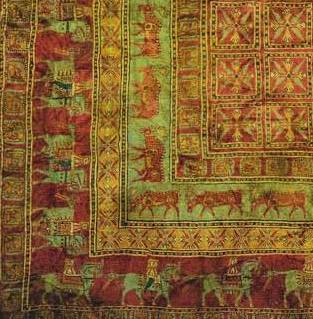
Handmade Persian rugs are among the oriental carpets and are called exquisite and patterned carpets that are woven in areas of West Asia and the Middle East, especially Iran. Many historical rugs that are kept in museums in the name of Persian were created in areas that in the past belong to the territory of the great ancient Persian Empire, and today no longer belong to Iran. Persian handmade rugs are characterized by special and unique patterns and motifs, high density, durable and eye-catching colors. The world’s oldest rug, the 2500-year-old Pazyryk Persian rug found in Siberia, still has its bold red color.
Red has a special place in Persian hand-woven rugs because this color is the favorite of most Iranians. A handmade Persian red rug is a prominent masterpiece that gives a unique effect to the room. If you want to decorate your home or workplace with a Persian red rug you must strike a delicate balance between the designs and colors of the furniture around it to dazzle the eyes.
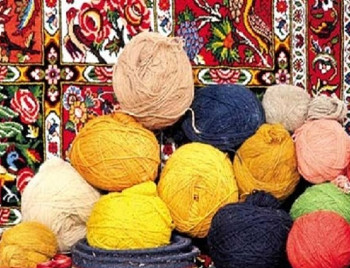
The root of the Rubia plant gives a strong red color. Rubia’s root has been an old and popular source for dyeing woolen coils used in carpet weaving. Moreover, Nomads who invented sophisticated carpet weaving techniques used a variety of native and imported plants, insects, and sea creatures to achieve the mesmerizing colors of Persian rugs. Snails, beetles, flowers, fruits, and plants, were used to dye goat and sheep wool and to make carpet weft. The weft threads in different colors were tied to the warp yarns to create a beautiful work of art on the carpet.
The scarcity of sources required for some dyes made it very expensive to produce some dyes, and they were rarely used in rugs. Having a carpet that had some rare colors expressed the wealth, power, and aristocracy of a person who was able to decorate a luxurious carpet with such rare colors in his house or palace.
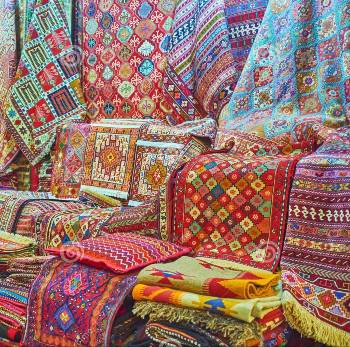
Attributes, goals, and emotions that are motivated by color change over time, just like anything else. Many carpet weaving designs originate from historical legends and myths, and this culture persists to this day and influences the choice of colors.
Green is a religious color and is reminiscent of hope, renewal, and paradise, so some parts of the rug were often woven in green, which did not have much footprint. Red was a symbol of happiness, joy, luck, courage, wealth, and vitality. Also, Blue was a symbol of loneliness, honesty, power, or life after death. Brown was reminiscent of soil and earth and was considered the color of fertility. Besides, Bright yellow symbolized the shining sun and was often reserved for kings and rulers. White meant purity and peace or sorrow. Moreover, Black was a strong and penetrating color that could indicate a destructive factor and was often left aside for the edges of the carpet to mark the boundaries of the map and give the design more design a more sight.
Persian rug weavers today use the same old dyes to produce colors similar to antique and luxury carpets. Rubia is still used today and many plants, m sects based dyes have been replaced by cheap, low-quality chemical dyes for some time. The precious beetle that once gave a vibrant red color to carpet yarns is now unaffordable, or at least too expensive to be used in carpet weaving. The steady, bright, non-toxic red of Cochineal insect larvae injects a great deal of energy, confidence, and excitement and has many applications in the food and cosmetics industries. You can find bright red ink in your favorite cherry syrup or lipstick, but you can’t find this fiery red under your feet on an old carpet woven in iconic, old-fashioned colors.
Steps to convert arranged wool from sheep to carpet:
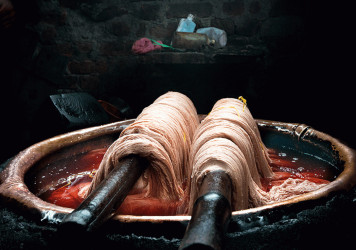
First of all, raw wool turns into a spool of yarn. Wool is the most widely used material in carpet weaving. Wool fibers are soft, beautiful, strong, and durable. As soon as the unprocessed wool reaches the carpet weaving workshop, its masses are separated by hand and any foreign material such as thorns and debris that is stuck to it is removed. The cleaned wool is then placed inside a spinning machine to obtain yarn fibers. The resulting fibers are wound into a coil. In the past, wool was spun by hand on the primary spinning wheel.
In the second step, the spun yarn is washed. The yarn is washed to remove dust and grease. Then it is thrown into the pot of detergent and squeezed several times. After that, the yarn is then washed with clean water to remove detergent. The washed yarn is then dried in the sun for two to three days.
In the third step, the washed yarn is dyed. The washed yarn is thrown on a rake and dipped in dye. To dye the yarn with the desired color, it must be heated for a while to a temperature close to the boiling point. The longer it boils, the darker the color will be. Then the dyed yarn is dried in direct sunlight.
Dyeing in a natural way is an ancient and attractive art that is more than four thousand years old. Old dyes were made based on instructions that were passed down from generation to generation. Actually, Rubia was one of the most important factors in dyeing. Rubia is a plant that grows in Iran and is the source of many colors such as red, pink and purple. Red worms and Cochineal insects are other sources of bluish-red color that live under oak trees.
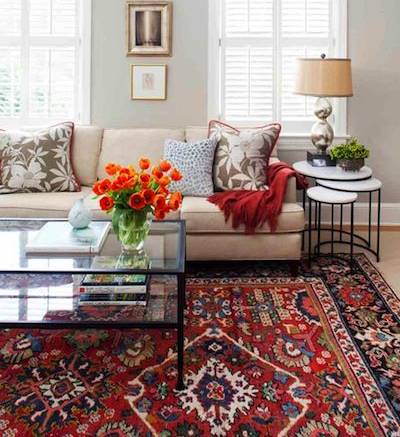
First of all, recognize what other dominant colors are in the carpet design besides the main background color red. Dark blue and cream can be seen in the pattern of most red carpets, while in other carpets light blue prevails. Choose your favorite colors for decoration and arrange them so that the rug is centered.
Center the rug and place the furniture around it to make the pattern or thorn in the middle of the rug more visible. Paint the wall a neutral color that matches the cream or ivory color used in the carpet. If you want to give more effect to the wall, choose one of the bold colors of the rug and paint the wall in that color. Additionally, Try not to use red decoration around the carpet, because this way the carpet loses its effect; You can use dark colors such as black, brown, or dark blue around the rug.
Place minimalist upholstered furniture in dark gray leather or velvet matches around the rug. You can put cushions on the sofa that have a red color in their design. Black leather sofa, cream chair with black and red cushions make the decoration with red carpet more beautiful. It is better to choose the frame of wall paintings in gray, silver, or dark colors. Try to use a picture that colors match the colors of the carpet. Place a vase of red flowers on the glass-lined middle table to make the room more magnificent. Be sure to choose a table in the middle of the glass so that the eye can reach the bright red carpet without obstruction beyond the glass.
Please take a look at our authentic Persian red rugs.
Get informed about exclusive sales , free delivery and discount coupons %